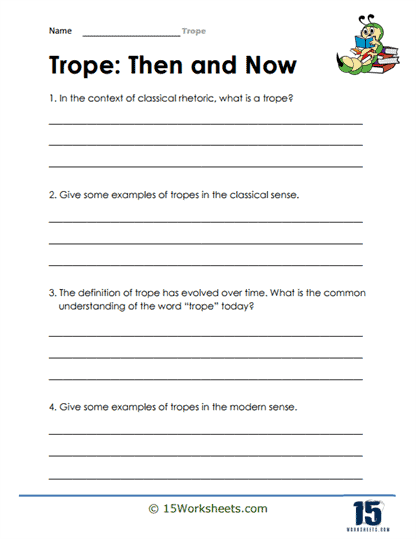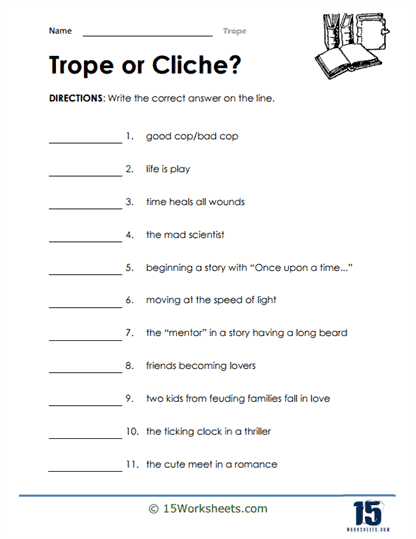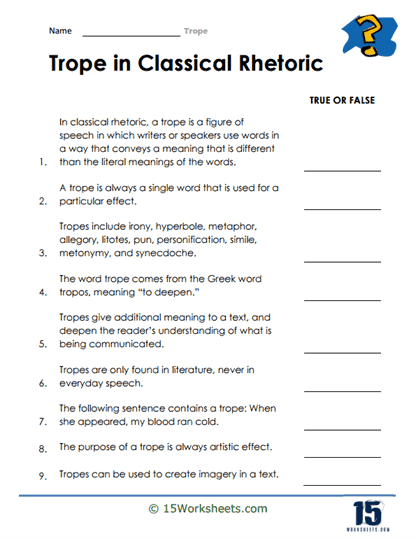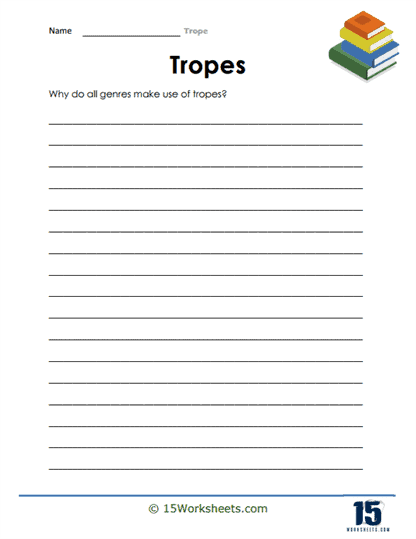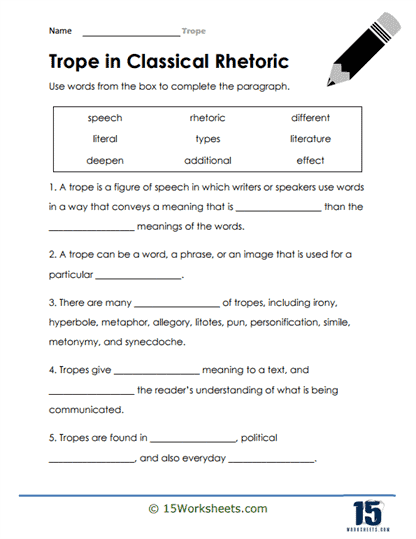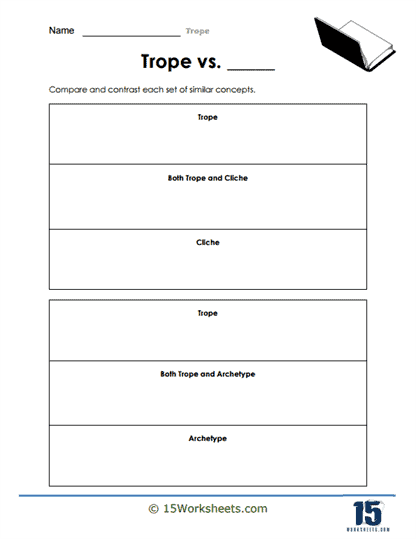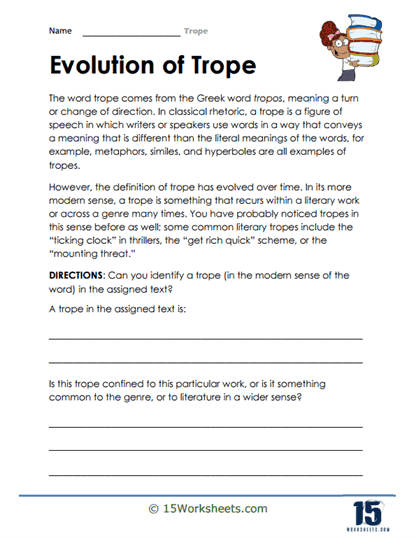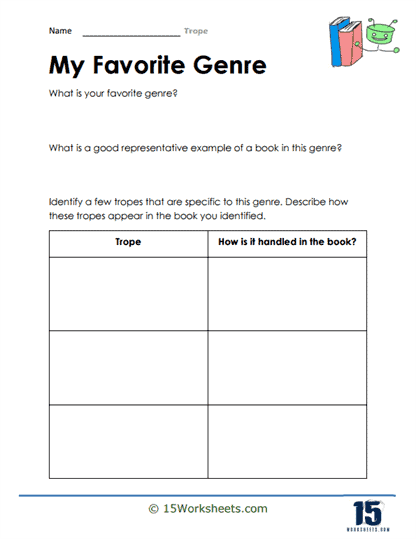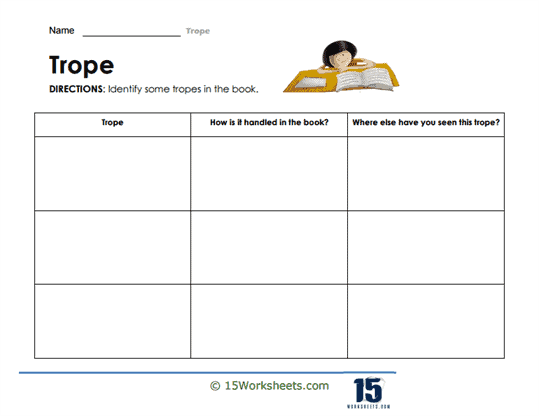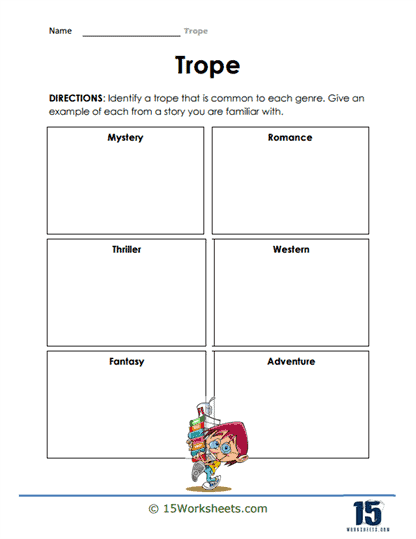Trope Worksheets
About These 15 Worksheets
In the vast landscape of storytelling, tropes serve as the fundamental building blocks that shape narratives across various mediums, from literature to film to television. Trope worksheets are invaluable tools for both budding and seasoned writers, providing a structured framework to dissect, analyze, and ultimately harness the power of these narrative devices. In this comprehensive exploration, we’ll delve into the essence of trope worksheets, delineate the diverse exercises they encompass, and elucidate their profound impact on enhancing language arts and reading skills.
At its core, a trope refers to a recurring theme, motif, or convention in storytelling, often embodying familiar patterns or archetypes. Trope worksheets serve as meticulous guides, offering writers a systematic approach to navigate the intricate tapestry of tropes within their narratives. These worksheets typically consist of various exercises designed to unravel the nuances of storytelling elements, fostering a deeper comprehension of literary techniques and enhancing creative proficiency.
Through diverse exercises encompassing identification, analysis, application, deconstruction, and synthesis, students cultivate critical thinking, creative expression, literary analysis, language proficiency, and contextual understanding. By mastering the art of tropes, students embark on a transformative journey towards becoming discerning readers, proficient writers, and astute interpreters of the literary landscape.
Types of Exercises
Tropes Identification
Students are tasked with identifying specific tropes within a given text, such as “The Hero’s Journey” or “The Love Triangle.” By recognizing and labeling tropes, students develop a keen eye for recurring narrative patterns, honing their analytical skills and fostering a deeper appreciation for storytelling conventions.
Tropes Analysis
Students analyze the role and significance of identified tropes within a narrative, exploring how they contribute to character development, plot progression, and thematic resonance. Through critical examination, students gain insight into the underlying dynamics of storytelling, discerning the interplay between tropes and narrative cohesion.
Tropes Application
Students are prompted to integrate specific tropes into their own creative writing projects, experimenting with how these devices can shape and enrich their narratives. By actively employing tropes in their writing, students cultivate versatility and ingenuity in storytelling, learning to wield tropes as potent tools for narrative expression.
Tropes Deconstruction
Students deconstruct familiar tropes, examining their origins, evolution, and cultural significance. Through historical and cultural contextualization, students gain a nuanced understanding of tropes as dynamic elements shaped by societal norms, ideologies, and artistic movements.
Synthesis
Students synthesize multiple tropes within a narrative, exploring how their convergence generates narrative complexity and thematic resonance. By synthesizing tropes, students develop a sophisticated understanding of narrative layering and subtext, cultivating the ability to craft multifaceted and resonant stories.
The Impact Of These Worksheets
Practicing with trope worksheets offers a myriad of benefits for students, enriching their understanding of language arts and reading skills in multifaceted ways:
Critical Thinking
Analyzing and dissecting tropes cultivates critical thinking skills, as students learn to discern underlying narrative structures, thematic motifs, and character archetypes. By engaging with trope worksheets, students develop the ability to evaluate texts with a discerning eye, identifying underlying themes, motifs, and narrative techniques.
Creative Expression
Experimenting with tropes through application exercises encourages creative expression, empowering students to infuse their writing with depth, nuance, and originality. As students integrate tropes into their own narratives, they learn to leverage these literary devices as catalysts for innovation and storytelling ingenuity.
Literary Analysis
Trope worksheets provide a platform for literary analysis, enabling students to explore the interplay between narrative elements, character dynamics, and thematic resonance. By deconstructing and synthesizing tropes, students deepen their appreciation for the complexities of storytelling, honing their ability to interpret and contextualize texts.
Language Proficiency
Engaging with trope worksheets enhances language proficiency by exposing students to diverse narrative conventions, idiomatic expressions, and rhetorical devices. Through tropes analysis and application, students expand their vocabulary, refine their syntax, and develop a nuanced understanding of linguistic nuances in storytelling.
Contextual Understanding
Delving into the historical and cultural dimensions of tropes fosters a broader contextual understanding of literature, as students explore how storytelling reflects and shapes societal norms, values, and ideologies. By situating tropes within their cultural contexts, students gain insight into the evolution of narrative conventions and the dynamic interplay between literature and society.
What is the Literary Device of Trope?
Within the realm of literature, tropes serve as indispensable tools wielded by authors to imbue their narratives with depth, resonance, and familiarity. In this discourse, we will unravel the essence of the literary device of trope, elucidating its main defining features, characteristics, and the profound impact it exerts on both writers and readers. Through the analysis of examples drawn from literature, we will delve into the intricate interplay between trope and narrative, illuminating the dynamic role this device plays in shaping storytelling.
A trope, in literary terms, refers to a recurring theme, motif, or convention that serves as a recognizable and often symbolic element within a narrative. Unlike clichés, which are overused and trite expressions, tropes are flexible narrative devices that can be employed creatively to evoke specific emotions, convey thematic concepts, or establish narrative frameworks. The main defining feature of a trope lies in its universality and adaptability, as it can manifest in myriad forms across diverse genres and cultural contexts.
Characteristics of a Trope
Recurrence – Tropes are characterized by their recurrence across different literary works, reflecting their enduring appeal and resonance with audiences.
Symbolism – Tropes often carry symbolic significance, serving as vehicles for conveying deeper thematic or allegorical meanings within a narrative.
Flexibility – Tropes possess a degree of flexibility, allowing authors to reinterpret, subvert, or combine them in innovative ways to suit the needs of their storytelling.
Archetypal Elements – Tropes frequently embody archetypal elements such as heroes, villains, quests, and love triangles, tapping into universal narrative motifs.
Cultural Context – Tropes are influenced by cultural, historical, and social contexts, reflecting the values, beliefs, and ideologies prevalent in a given society.
Examples of Tropes in Literature
The Hero’s Journey
Example – In J.R.R. Tolkien’s “The Lord of the Rings,” the protagonist Frodo Baggins embarks on a perilous quest to destroy the One Ring, following the classic hero’s journey pattern of departure, initiation, and return.
Analysis – The Hero’s Journey trope provides a narrative framework that allows readers to vicariously experience the protagonist’s growth, challenges, and eventual triumph, tapping into the timeless allure of heroic narratives.
Effect on the Reader – By engaging with the Hero’s Journey trope, readers are drawn into a compelling narrative arc that resonates with themes of courage, sacrifice, and redemption, fostering emotional investment in the protagonist’s quest.
The Femme Fatale
Example – In Raymond Chandler’s “The Big Sleep,” the character of Vivian Rutledge embodies the archetype of the femme fatale, a seductive and enigmatic woman whose allure conceals hidden motives and duplicity.
Analysis – The Femme Fatale trope adds intrigue and complexity to the narrative, as the character’s ambiguous motivations and manipulative tactics challenge the protagonist’s assumptions and drive the plot forward.
Effect on the Reader – The Femme Fatale trope captivates readers with its aura of mystery and danger, eliciting a sense of suspense and anticipation as they navigate the shifting allegiances and moral ambiguities of the narrative.
The Rags to Riches
Example – In Charles Dickens’ “Great Expectations,” the protagonist Pip undergoes a transformation from humble orphan to wealthy gentleman, embodying the Rags to Riches trope.
Analysis – The Rags to Riches trope explores themes of ambition, social mobility, and the pursuit of identity, tracing the protagonist’s journey from adversity to prosperity and the moral complexities that accompany newfound wealth.
Effect on the Reader – The Rags to Riches trope resonates with readers’ aspirations for self-improvement and success, while also prompting reflection on the ethical implications of ambition and materialism, fostering empathy and introspection.
The Impact of Tropes on the Reader
Tropes exert a multifaceted impact on readers, shaping their emotional engagement, cognitive processing, and interpretive frameworks. By tapping into familiar narrative patterns and archetypal motifs, tropes evoke a sense of recognition and resonance, facilitating reader immersion and empathy with characters and themes. Furthermore, tropes serve as vehicles for conveying complex ideas, moral dilemmas, and social commentary, inviting readers to contemplate universal truths and enduring human experiences. However, tropes also carry the risk of predictability and cliché if used uncritically, underscoring the importance of creative reinterpretation and subversion to maintain narrative freshness and vitality.


